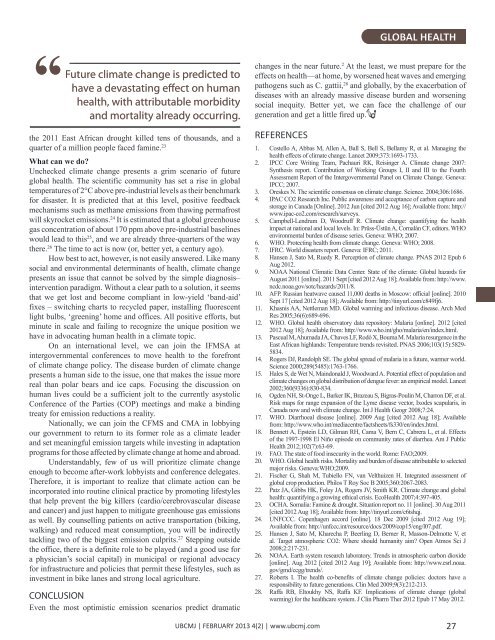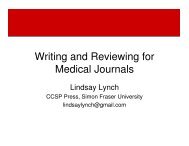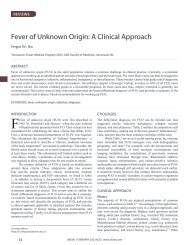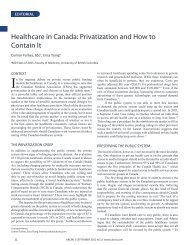Download full PDF - UBC Medical Journal
Download full PDF - UBC Medical Journal
Download full PDF - UBC Medical Journal
You also want an ePaper? Increase the reach of your titles
YUMPU automatically turns print PDFs into web optimized ePapers that Google loves.
GLOBAL HEALTH<br />
“<br />
Future climate change is predicted to<br />
have a devastating effect on human<br />
health, with attributable morbidity<br />
and mortality already occurring.<br />
the 2011 East African drought killed tens of thousands, and a<br />
quarter of a million people faced famine. 23<br />
What can we do<br />
Unchecked climate change presents a grim scenario of future<br />
global health. The scientific community has set a rise in global<br />
temperatures of 2°C above pre-industrial levels as their benchmark<br />
for disaster. It is predicted that at this level, positive feedback<br />
mechanisms such as methane emissions from thawing permafrost<br />
will skyrocket emissions. 24 It is estimated that a global greenhouse<br />
gas concentration of about 170 ppm above pre-industrial baselines<br />
would lead to this 25 , and we are already three-quarters of the way<br />
there. 26 The time to act is now (or, better yet, a century ago).<br />
How best to act, however, is not easily answered. Like many<br />
social and environmental determinants of health, climate change<br />
presents an issue that cannot be solved by the simple diagnosis–<br />
intervention paradigm. Without a clear path to a solution, it seems<br />
that we get lost and become compliant in low-yield ‘band-aid’<br />
fixes – switching charts to recycled paper, installing fluorescent<br />
light bulbs, ‘greening’ home and offices. All positive efforts, but<br />
minute in scale and failing to recognize the unique position we<br />
have in advocating human health in a climate topic.<br />
On an international level, we can join the IFMSA at<br />
intergovernmental conferences to move health to the forefront<br />
of climate change policy. The disease burden of climate change<br />
presents a human side to the issue, one that makes the issue more<br />
real than polar bears and ice caps. Focusing the discussion on<br />
human lives could be a sufficient jolt to the currently asystolic<br />
Conference of the Parties (COP) meetings and make a binding<br />
treaty for emission reductions a reality.<br />
Nationally, we can join the CFMS and CMA in lobbying<br />
our government to return to its former role as a climate leader<br />
and set meaningful emission targets while investing in adaptation<br />
programs for those affected by climate change at home and abroad.<br />
Understandably, few of us will prioritize climate change<br />
enough to become after-work lobbyists and conference delegates.<br />
Therefore, it is important to realize that climate action can be<br />
incorporated into routine clinical practice by promoting lifestyles<br />
that help prevent the big killers (cardio/cerebrovascular disease<br />
and cancer) and just happen to mitigate greenhouse gas emissions<br />
as well. By counselling patients on active transportation (biking,<br />
walking) and reduced meat consumption, you will be indirectly<br />
tackling two of the biggest emission culprits. 27 Stepping outside<br />
the office, there is a definite role to be played (and a good use for<br />
a physician’s social capital) in municipal or regional advocacy<br />
for infrastructure and policies that permit these lifestyles, such as<br />
investment in bike lanes and strong local agriculture.<br />
CONCLUSION<br />
Even the most optimistic emission scenarios predict dramatic<br />
changes in the near future. 2 At the least, we must prepare for the<br />
effects on health—at home, by worsened heat waves and emerging<br />
pathogens such as C. gattii, 28 and globally, by the exacerbation of<br />
diseases with an already massive disease burden and worsening<br />
social inequity. Better yet, we can face the challenge of our<br />
generation and get a little fired up.<br />
REFERENCES<br />
1. Costello A, Abbas M, Allen A, Ball S, Bell S, Bellamy R, et al. Managing the<br />
health effects of climate change. Lancet 2009;373:1693-1733.<br />
2. IPCC Core Writing Team, Pachauri RK, Reisinger A. Climate change 2007:<br />
Synthesis report. Contribution of Working Groups I, II and III to the Fourth<br />
Assessment Report of the Intergovernmental Panel on Climate Change. Geneva:<br />
IPCC; 2007.<br />
3. Oreskes N. The scientific consensus on climate change. Science. 2004;306:1686.<br />
4. IPAC CO2 Research Inc. Public awareness and acceptance of carbon capture and<br />
storage in Canada [Online]. 2012 Jun [cited 2012 Aug 16]; Available from: http://<br />
www.ipac-co2.com/research/surveys.<br />
5. Campbell-Lendrum D, Woodruff R. Climate change: quantifying the health<br />
impact at national and local levels. In: Prüss-Üstün A, Cornalán CF, editors. WHO<br />
environmental burden of disease series. Geneva: WHO; 2007.<br />
6. WHO. Protecting health from climate change. Geneva: WHO; 2008.<br />
7. IFRC. World disasters report. Geneva: IFRC; 2011.<br />
8. Hansen J, Sato M, Ruedy R. Perception of climate change. PNAS 2012 Epub 6<br />
Aug 2012.<br />
9. NOAA National Climatic Data Center. State of the climate: Global hazards for<br />
August 2011 [online]. 2011 Sept [cited 2012 Aug 18]; Available from: http://www.<br />
ncdc.noaa.gov/sotc/hazards/2011/8.<br />
10. AFP. Russian heatwave caused 11,000 deaths in Moscow: official [online]. 2010<br />
Sept 17 [cited 2012 Aug 18]; Available from: http://tinyurl.com/c849fj6.<br />
11. Khasnis AA, Nettleman MD. Global warming and infectious disease. Arch Med<br />
Res 2005;36(6):689-696.<br />
12. WHO. Global health observatory data repository: Malaria [online]. 2012 [cited<br />
2012 Aug 18]; Available from: http://www.who.int/gho/malaria/en/index.html.<br />
13. Pascual M, Ahumada JA, Chaves LF, Rodó X, Bouma M. Malaria resurgence in the<br />
East African highlands: Temperature trends revisited. PNAS 2006;103(15):5829-<br />
5834.<br />
14. Rogers DJ, Randolph SE. The global spread of malaria in a future, warmer world.<br />
Science 2000;289(5485):1763-1766.<br />
15. Hales S, de Wet N, Maindonald J, Woodward A. Potential effect of population and<br />
climate changes on global distribution of dengue fever: an empirical model. Lancet<br />
2002;360(9336):830-834.<br />
16. Ogden NH, St-Onge L, Barker IK, Brazeau S, Bigras-Poulin M, Charron DF, et al.<br />
Risk maps for range expansion of the Lyme disease vector, Ixodes scapularis, in<br />
Canada now and with climate change. Int J Health Geogr 2008;7:24.<br />
17. WHO. Diarrhoeal disease [online]. 2009 Aug [cited 2012 Aug 18]; Available<br />
from: http://www.who.int/mediacentre/factsheets/fs330/en/index.html.<br />
18. Bennett A, Epstein LD, Gilman RH, Cama V, Bern C, Cabrera L, et al. Effects<br />
of the 1997-1998 El Niño episode on community rates of diarrhea. Am J Public<br />
Health 2012;102(7):63-69.<br />
19. FAO. The state of food insecurity in the world. Rome: FAO;2009.<br />
20. WHO. Global health risks. Mortality and burden of disease attributable to selected<br />
major risks. Geneva:WHO;2009.<br />
21. Fischer G, Shah M, Tubiello FN, van Velthuizen H. Integrated assessment of<br />
global crop production. Philos T Roy Soc B 2005;360:2067-2083.<br />
22. Patz JA, Gibbs HK, Foley JA, Rogers JV, Smith KR. Climate change and global<br />
health: quantifying a growing ethical crisis. EcoHealth 2007;4:397-405.<br />
23. OCHA. Somalia: Famine & drought. Situation report no. 11 [online]. 30 Aug 2011<br />
[cited 2012 Aug 18]; Available from: http://tinyurl.com/c6tshqj.<br />
24. UNFCCC. Copenhagen accord [online]. 18 Dec 2009 [cited 2012 Aug 19];<br />
Available from: http://unfccc.int/resource/docs/2009/cop15/eng/l07.pdf.<br />
25. Hansen J, Sato M, Kharecha P, Beerling D, Berner R, Masson-Delmotte V, et<br />
al. Target atmospheric CO2: Where should humanity aim Open Atmos Sci J<br />
2008;2:217-231.<br />
26. NOAA. Earth system research laboratory. Trends in atmospheric carbon dioxide<br />
[online]. Aug 2012 [cited 2012 Aug 19]; Available from: http://www.esrl.noaa.<br />
gov/gmd/ccgg/trends/.<br />
27. Roberts I. The health co-benefits of climate change policies: doctors have a<br />
responsibility to future generations. Clin Med 2009;9(3):212-213.<br />
28. Raffa RB, Eltoukhy NS, Raffa KF. Implications of climate change (global<br />
warming) for the healthcare system. J Clin Pharm Ther 2012 Epub 17 May 2012.<br />
<strong>UBC</strong>MJ | FEBRUARY 2013 4(2) | www.ubcmj.com<br />
27










